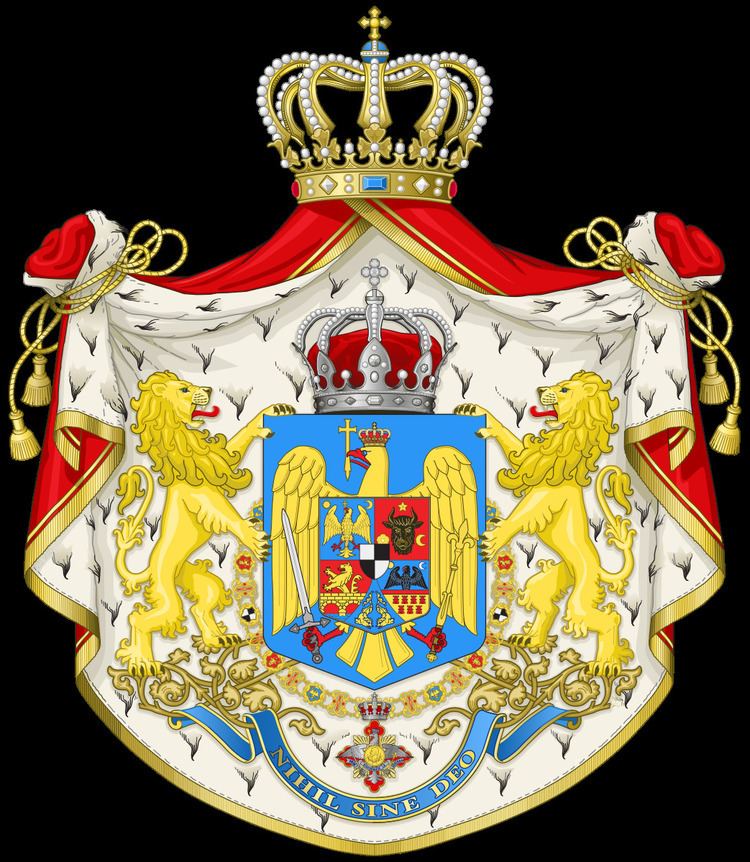 | ||
The succession order to the throne of the Romanian monarchy, abolished since 1947, was regulated by the monarchical constitution of 1923 and the 1884 Law of the Romanian Royal House Rules enacted pursuant to the 1866 Constitution of Romania which had confirmed the enthronement of Prince Karl (Carol) of Hohenzollern-Sigmaringen. The defunct 1923 Constitution stipulated Salic law, according to which the throne was hereditary in King Carol I's legitimate descent and, if his male issue failed, in the descent of his brothers of the Sigmaringen princely branch of the House of Hohenzollern, according to agnatic primogeniture and to the perpetual exclusion of females and their descendants. The last monarch to reign in Romania was King Michael I, who was born in 1921, abdicated his throne on 30 December 1947 under coercion, and went into exile in Switzerland.
Contents
Present situation
Former King Michael has no sons, nor are there any undisputed legitimate male-line male descendants of the previous kings of Romania.
There are male line descendants of King Carol II: Paul of Romania (b. 1948), his son Carol Ferdinand (b. 2010), and Alexandru Hohenzollern (b. 1961). Paul and Alexandru are the sons of Carol Mircea Hohenzollern, also known as Carol Mircea Grigore of Romania (according to his Romanian birth certificate). Carol Mircea (8 January 1920 - 27 January 2006) is the issue of King Carol's first marriage to Zizi Lambrino, which marriage had been declared null and void on 18 January 1919 by a Romanian court. In 1955, however, a Portuguese court declared Carol Mircea as former King Carol II's legitimate son, a ruling later confirmed by a Parisian court. The court rulings allowed him to bear the surname Hohenzollern and to inherit a portion of his father's properties, but did not confer upon him any dynastic rights to the defunct Romanian throne or rights to bear a princely title and style, despite his use of both. In October 1995 a Romanian court ruling also recognized Carol Mircea as a legitimate son of Carol II, allowing him the right to bear the surname "al României", a ruling which evoked some speculation that called into question the status of Michael. The court ruling was cited by Paul to assert a right to the title "Prince". The argument which appears prevalent is that Mircea Carol's sons would not be entitled to succession rights, due to the non-dynastic nature of their grandparents' marriage. Moreover, Carol Mircea never claimed any right to the Romanian throne, unlike his son, Paul.
Following King Michael's abdication the line of succession was discussed during a meeting between Michael, his uncle Prince Nicholas of Romania, and Frederick, Prince of Hohenzollern (1891-1965). Shortly after this meeting, the spokesman of Carol II, in an interview with the French paper Le Figaro, said that Carol, who was not in contact with Michael, strongly supported Prince Frederick, additionally asserting that Michael would never regain the throne.
According to the succession provisions of the kingdom's last democratic constitution, that of 1923, agnatic primogeniture and so-called "Salic law" determine who would inherit the throne. After two intervening changes of regime, that constitution no longer carries legal weight, although the 1884 Law of Romanian Royal House Rules was never abrogated . It must also be said that the German Hohenzollerns in the succession line descend from the previously mentioned Prince Frederick, the oldest son of Wilhelm, Prince of Hohenzollern who, along with his father, Prince Leopold, renounced his rights to the Romanian throne in favor of his younger brother, the future King Ferdinand.
Succession by Salic law
Notes:
X Excluded due to the annulment of Carol II's marriage to Zizi Lambrino.In case of the extinction without any direct male heirs of all eligible Hohenzollerns or of their refusal to accept the throne, according to article 78 of the last democratic royal Constitution of Romania from 1923, the throne becomes vacant. In this situation, article 78 provided that the last reigning king had the right to nominate a foreign prince from a reigning dynasty of Western Europe as successor, subject to the Parliament's approval as required by article 79. The Parliament incurs the final responsibility, according to article 79, of electing a king from a reigning dynasty of Western Europe if, prior to his investiture, he had committed to raise his descendants in the Eastern Orthodox faith to comply with article 77 of the Constitution.
In 1997, Romanian monarchist leaders asked former King Michael to designate a male heir presumptive from the German branch of the family, in keeping with the rules of the last royal constitution. Under the influence of his wife Anne, the former King rejected the request and, at the end of 1997, he designated his first born, Princess Margarita, as heir presumptive.
In a 2009 interview, Karl Friedrich, then Hereditary Prince of Hohenzollern, stated that he was not interested in the Romanian throne.
